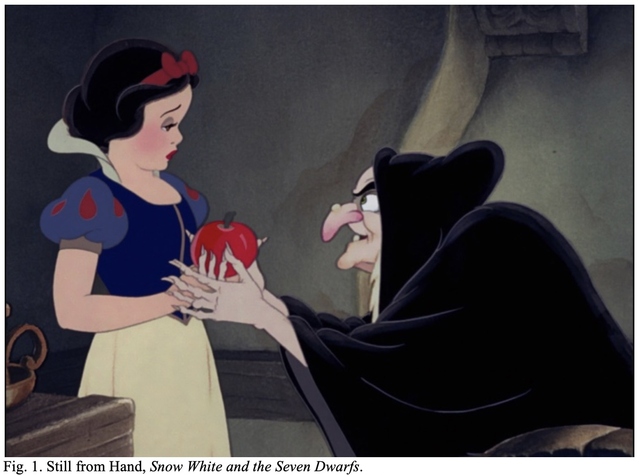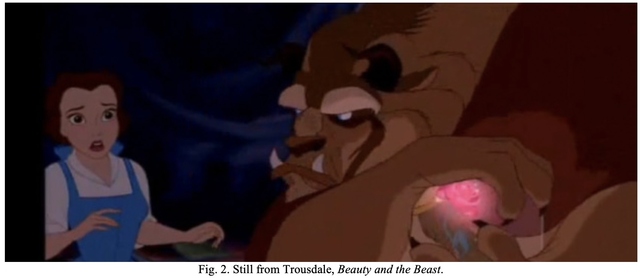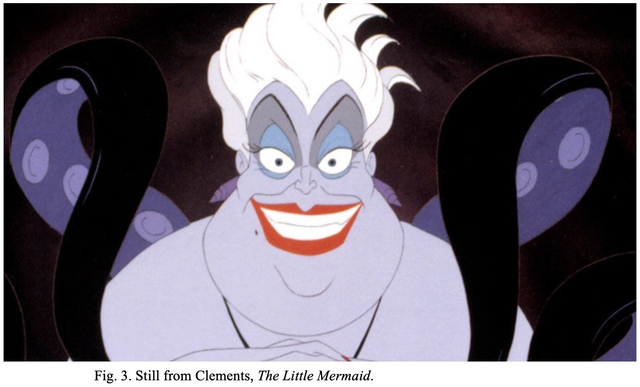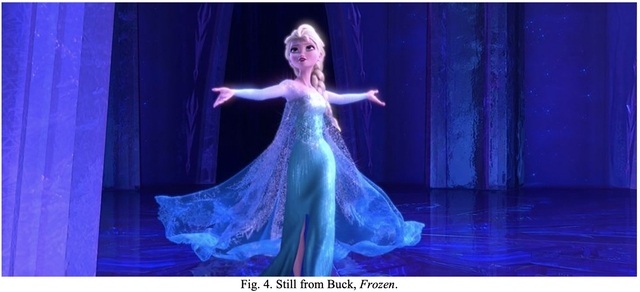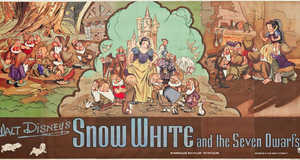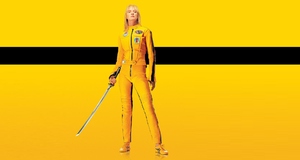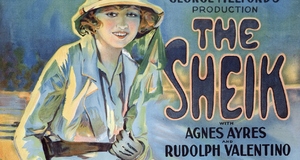Toxic Royalty: Feminism and the Rhetoric of Beauty in Disney Princess Films
By
2020, Vol. 12 No. 07 | pg. 1/1
IN THIS ARTICLE
KEYWORDS
At Disneyland’s Magic Kingdom, light cascades across the night sky before spiraling down through the stars. The castle that towers within the dark shines bright amongst the fireworks’ sparkling ceruleans and violets. Once the night show rises to a crescendo of color and song, the snaps of cameras coalesce with the symphony as spectators strive to capture the moment in time. Such a scene stands as a cherished childhood dream, cemented at the heart of the contemporary American identity. Since the birth of Walt Disney’s animation studio, countless children have become spellbound by the Disney brand. Within is a realm separate from reality, one where royalty presides and sorcery prospers. Yet sorcery, by connotation, conveys deceit. The lustrous glamour of the classic Disney fantasy shrouds a subtle toxicity uncloaked through stereotypes of a beautiful princess. Although such princess characters are commonly memorialized in treasured childhood memory, beyond the sentimental charm stands chauvinistic pressures of domesticity and subservience that parallel the norms women confront in society. To counter the patriarchal reality, shares of Americans have advocated for women to possess comparable rights, treatment, and opportunities as their male counterparts. Such acts aspiring to societal change can be categorized in four separate waves of feminism on America’s timeline. The primary wave marks a battle for women’s suffrage, sparked within a rising liberal atmosphere in politics and urbanization during the late 19th century. Kindled by civil rights movements and oppositions to war, the second wave connects to a push for reproductive rights, the acceptance of sexuality, and the gradual close of the disparity in social treatment across sexes within the home and the workplace. Third-wave feminism has become defined by a concentration on individuality, while the succeeding fourth wave stretching to present day has targeted misogynistic mindsets that have spiraled to sexual harassment and assault (Rampton). The collective four waves and the supervening feminist criticism lens have sparked changes in women’s portrayals in media, ranging from literature to cinema.The outlined rise and development of the feminist lens strives against the prejudiced norms perpetuated within Disney’s commercial sphere. Scrutinizing pictures and scenes that star Disney princesses, as well as scholarly literature centering on Disney’s messages to women, this paper argues that classic Disney princesses and villainesses alike have shaped toxic stereotypes that cater primarily to male spectatorship. Such stereotypes confine women within the mold of passivity and ultimately, under male control. Despite the creation of more dynamic princesses over time, modern princesses remain caged in subtle ways through the minimization of female autonomy or an overarching dependence on a knight in shining armor. The supreme achievement for a woman in princess stories is then to be demure, beautiful, powerless—the paragon of a romanticized lady. Consequently, significant progress must come to pass in order to continually shift the storylines of Disney princesses towards richer, more complex representations of women. The Age of the Classic Disney Princess: 1937-1967Princesses created within Disney’s Golden or Silver Ages, marked as the time prior to Walt Disney’s death and second-wave feminism, mirror the model woman shaped by the 19th century’s cult of domesticity. Characterized by the notion that women should stay within the home and honor the paramount principles of purity and submission, the cultural system served to smother both intellectual and personal pursuits. Under the system, a woman relies solely on the protection of a husband, so that the ultimate happy ending revolves around marriageability. Such cultural romanticization of domesticity is absorbed by the storylines of classic Disney cartoons, all created by men. During a scene of Snow White and the Seven Dwarfs (1937), the titular princess sings amongst dancing woodland creatures as she cleans the house—“Just whistle while you work / And cheerfully together we can tidy up the place” (Hand). She then represents the paradigm of the compliant woman, content with chores and awaiting a dazzling prince’s love. As she lies poisoned on her deathbed, the prince in question revives her from her curse with a kiss. The animation then shapes a sense of reward—a docile woman that happily commits to standard duties within the household is met with the appearance of a male savior. Similarly, the story of Cinderella (1950) rewards obedient servitude—Cinderella cleans the house and withstands relentless cruelty from her stepmother and sisters, but ultimately reaches the dream of marrying Prince Charming and living within a luxurious palace. Only by wedding her royal savior, then, does Cinderella become liberated from her abusive household. Such stories created within the classic Disney age thus link to the concept of male saviorism as the ultimate symbol of romance. Within Sleeping Beauty (1959), the prince slays Maleficent in the shape of a dragon in order to rescue Aurora from her destiny of confinement. Upon the villainess’s demise, he rushes to the castle to kiss, and in turn awaken, the passive Aurora from her deathly slumber. Paralleling the story of Snow White, Sleeping Beauty continues to shape a line of kingdoms where women are deemed damsels in distress. Women in danger are then told to rely on a princely, masculine power as protection. Such a shield, however, comes with chains. As princesses’ happy endings are pictured solely within the context of a prince, women are in turn stripped of a sense of self outside the relation to the man they are chained to. Romance subsequently rises to the utmost priority as any semblance of princesses’ own aspirations is relegated to the shadows. To achieve a storybook romance, and in succession happiness, a princess must above all lack autonomy and typify superficial, passive beauty. Within Screen Education, a scholarly publication centering on film and other media-related subjects, contributor Sam Higgs writes that both Snow White’s and Aurora’s “lips are described as being as red as a rose…and both are presented with flowers when comatose. The association with flowers can be seen as a comment on the characters’ fleeting beauty—their only power to gain a husband before they wilt and lose their bouquet” (Higgs 64). The stress on passive beauty then sends a subliminal message that women should strive to be physically beautiful above all, and that the absence of beauty splinters princesses’ worth and suppresses their success. Consequently, the superficiality of outer beauty smothers all intrinsic motivations and ambitions, so that merely a shell of a character remains. Beauty in classic Disney princess movies has not only become laced with passivity and romantic desirability, but also with a character's benevolence. Evil characters are traditionally depicted as ghastly or malformed, as their angelic counterparts stay attractive and pristine. Despite her toxic obsession with beauty in the story of Snow White, the Evil Queen morphs into a cadaverous old lady as she commits her ultimate act of deceit—poisoning the princess. As she presents the cursed apple to Snow White (see fig. 1), the picture onscreen creates a sharp contrast through both the characters’ superficial appearance and their underlying purity. Snow White stands straight and looks down almost shyly under curled lashes. Her rosy cheeks complement the scarlet accents of her dainty royal dress. The Evil Queen, in contrast, is misshapen, cloaked in black and sketched with a crooked nose and chin as her skeletal hands clasp Snow White’s. Snow White is then painted as a pure, bashful lady beside a loathsome, sinister queen. Similarly, Sleeping Beauty’s Maleficent is pictured as a cruel sorceress shrouded within a midnight cloak and possessing demon-like horns, contrasting with the golden-haired, rosy-lipped Aurora. Feminist scholar Alexandra Heatwole continues to shed light on such depictions of evil within Disney narratives, particularly on how “the princess is accorded the qualities of emphasized femininity” while “her competitors are portrayed as possessing alternative physical traits and qualities coded as bad” (Heatwole 6). The presence of a beautiful, pure princess alongside a malevolent villainess then creates a juxtaposition that accentuates the characters’ respective qualities, and in turn, the beauty-goodness stereotype. Business school professors Griffin, Harding, and Learmonth delve deeper into the contrast between good and evil, noting that Disney’s classic villainesses are “powerful, agentive, strong, fearless, mature, independent and in control,” yet unlike the passive, static princesses, “they all suffer the same fate—they are destroyed” (Griffin et al. 880). With beauty as a symbol of a woman’s character, Disney movies then strengthen the notion that superficial qualities trump all others, and that complex motivations and mindsets are secondary. Such a notion has substantial consequences in reality. As outlined by the article “Little girls or little women? The Disney princess effect,” young girls in contemporary America step “down a path to [scary] challenges, fromself-objectification to cyberbullying” as they sport mascara, dress with padded bras, and post suggestive pictures on social media (Hanes). Such a culture stresses a woman’s sexuality rather than her accomplishments. Consequently, children learn to assess her worth solely under the culture’s lascivious lens. As in Disney stories, once a critical surface-level beauty wanes, she could morph into a creature that is tormented, evil, and strictly undesirable to the male eye. An ugly woman, then, becomes one that is banished from society. Such punishment of female strength, centering on the beauty-goodness trope, serves to lay the foundation for the archetypal princesses and villainesses of later years. Princesses of the Disney Renaissance: 1989–1999The changes in societal attitudes towards women sparked after second-wave feminism in ways mirror a subtle shift in the storylines of Disney’s Renaissance princesses. Classic Disney princesses, with their simple characterizations and romantic narratives, were abandoned in order to appeal to a more modern target audience and construct a portrayal “of girlhood appropriate to its time” (Heatwole 3). The rise of third-wave feminism then parallels the more complex princess stories during the period. Contrasting with classic Disney animations, Beauty and the Beast (1991) was written by a woman, Linda Woolverton, who aspired to create a princess suitable to “the Nineties…[so] that the story isn’t sexist” (qtd. in Thomas 143). To a degree, Beauty and the Beast succeeds by circumventing some traditional stereotypes, but ultimately capitulates to patriarchal norms. Straying from the domestic, marriage-minded princesses of the past, Belle rebukes Gaston’s courtship upon the story’s commencement. However, despite her lack of desire for romance in favor of books’ mental stimulation, her community scorns her due to her unique love of literature. Children’s literature specialist June Cummins notes the townspeople’s animosity towards Belle’s desire to read—“It is clear that Belle does not fit into her town…because she has ‘a dreamy far-off look / and a nose stuck in a book.’ Reading is the symbol of this difference” (Cummins 24). Rather than rewarding the princess for intellectual curiosity, as a classic Disney story would reward romance, the storyline then treats Belle as an anomaly. Deviating from passive stereotypes, however, Belle courageously acts to rescue her father from the Beast’s dungeon rather than depending on a male savior. Such a shift in the Disney narrative arises from a call for stronger women represented in American media during the time. However, the slight success of a self-reliant female character is soon derailed due to the overarching concept of male superiority. Belle’s liberation from patriarchal norms and the subsequent pressure pulling her back to the strictly gendered realm can be symbolized through Beauty and the Beast’s scene in the West Wing (see fig. 2). To satisfy her curiosity, Belle wanders within the dark to the castle’s barred sector. Ultimately, she is discovered. “I warned you to never come here,” the Beast snarls as he smashes shards of furniture in Belle’s direction. As he looms within the shadows, his fury scares Belle away, both from the sector of the castle and from her connate curiosity. Her terror is painted clearly within the scene’s still—her eyes are widened and her arms splayed before her chest as if to shield her heart from a monster. Like her treasured autonomy, the luminous rose is caged within the Beast’s claws. He corners Belle with a cold stare, occupying most of the space on the screen with his body. However, after the scene and an attempt to bolt from the Beast’s castle, Belle ultimately falls in love with her violent captor. Her story then descends into the traditional narrative of “pretty costumes, rosy music and high-key lighting. By the end of the film, she dances into the future with herhandsome prince” (Higgs 67). The moment at the West Wing and the animation’s subsequent scenes then reveal a norm that men should have the power to control the women in their lives, and should reinforce that control with violent behavior. Beauty and the Beast in turn parallels a status quo for women—if women are too autonomous, and consequently stray from patriarchal boundaries set since childhood, they will be brutally thrust back and punished. Such a dynamic between Belle and the Beast mirrors the harsh reality of domestic violence. The Beast presents common abuser behavior—he locks Belle on castle premises, yells to control her actions, and displays physical violence. Troublingly, LeeAnn Kahlor and Matthew S. Eastin, associate professors of the University of Texas at Austin, note that television stands as “a purveyor of cultural norms at the macrosystem level, norms that are embedded in a culture of violence towards women” (Kahlor and Eastin 225). Destructive subordination of women with respect to men in society is in turn strengthened by the media. Those within the damaging culture learn that women are merely subservient objects to be wounded, controlled, and oppressed. Ultimately, they are deemed as undeserving of proper treatment and consequently become susceptible to domestic abuse and assault. Similar to abusive relationships in reality, the Beast’s toxic behaviors are condoned once the Beast belatedly shows concern, shielding Belle from wolves. By overlooking abuse in this manner, both Belle and the real women she symbolizes continuously dodge the looming threat of a partner’s rage and become locked in a cycle of maltreatment. Similar concepts of male control smothering a semblance of female autonomy can be drawn from The Little Mermaid (1989), a story locked in development limbo since the time of the classic Disney princess, and similarly written and directed by men. Within the narrative, Ariel strives against paternal power, straying from the sea kingdom in order to satiate her passion for adventure. Nonetheless, Ariel’s mind soon becomes centered on a prince after a strike of love at first sight. Like the princesses before her, Ariel then achieves the ultimate dream of marrying a beloved prince, but at a steep cost—her treasured voice, her childhood home, and her culture in the sea. Above all, however, Ariel skirts around death after a dangerous deal made with the story’s villainess. A woman’s life is consequently depicted as secondary to a man’s love and a worthy sacrifice to be made. Ursula (see fig. 3), the sea witch that creates the deal with Ariel, possesses the twisted body of an octopus and a smile curled with malice—in turn, she parallels the malformed villainesses of classic Disney movies. She leers as if to suggest that she is not threatened by the onlooker, but rather sparks trepidation in others. Within the still, paradoxical standards are also applied to Ursula’s appearance. Notably, her characterization as evil is connected with her appearing “plump and buxom—a trait emphasized grotesquely to suggest sexual over-availability” (Heatwole 6). To be overtly sexual is then, above all, stressed as undesirable. Consequently, women are told to tread the delicate line of desired femininity, as opposed to “‘bad’ femininity: femininity lost with age, femininity oversexualized, femininity gone wrong” (Heatwole 6). A primary aspiration for women then becomes shaping superficial appearance to be suitable for the male lens, rather than self-satisfaction. Along with connections to sexuality, Ursula’s countenance, curves, and dark tentacles are reminiscent of a black woman. A racial component then looms—one that declares a white woman as a lovely, benevolent star and a black woman as the movie’s hypersexualized villainess. Such a villainess shapes a divide mirrored in reality, in which black Americans are targeted with negative stereotypes and discrimination due to the color of their skin. Disney’s depiction of Ursula then not only uncloaks, but sustains a racially chauvinistic culture and its history of oppression. Moreover, The Little Mermaid’s negative racial connotations match those in Pocahontas (1995), a story starring a Native American princess, yet directed by two white men. Pocahontas is characterized as adventurous and spirited, standing as Disney’s first lead woman of color. However, her story ultimately centers upon her ceaseless love for a white male. Pocahontas’s whitewashed, dreamy delusion then silences the Native American history it paints—bloody conquest is substituted with a romanticized rewrite. At the story’s climax, Pocahontas shields her white lover from a lethal weapon, stressing the overshadowing concept that a woman should commit to romantic sacrifice, and that a Native American life is secondary within the scheme of a white man’s survival. Then, although the completion of second-wave feminism and its combat against the leash of male control shaped slight changes to the princess narrative, norms of subservience continued to subsist. Princesses of the Revival Era: 2009-presentThe culmination of activism sparked by four collective waves of feminism parallels continuous changes to princesses of the Disney Revival. Alongside advocacy for women to be portrayed outside of timeworn stereotypes, princesses shifted to display more power, autonomy, and other traditionally masculine traits. As summarized by seasoned Disney director Chris Buck, “Disney had already done the ‘kissed by a prince’ thing, so thought it was time for something new” (qtd. in Williams). Yet, remnants of a patriarchal past still linger within modern princess storylines, mirroring the norms that persist in contemporary society. After a lull in Disney animation sales, Tangled (2010)’s directors sought to stress “girl power,” a term linked with third-wave feminism, within a reversal of Disney princesses’ passive, conventionally ladylike characteristics (Frost). Rapunzel demonstrates artistic creativity through her various paintings, as well as bravery and spirit as she masterminds her escape from her tower. For Rapunzel, the domestic sphere to which women are traditionally assigned proves dull and monotonous. Her character moreover contrasts sharply with most classic Disney princesses in that she possesses a set aspiration separate from a male savior—to pinpoint the source of the royal lanterns she witnesses annually as they rise within the night sky. Yet, her non-traditional characteristics are ultimately eclipsed by the story’s conclusion. Rather than a concentration on the actualization of Rapunzel’s personal dreams, Tangled’s happily ever after centers on Rapunzel’s marriage to Flynn Rider. Her story then culminates to a spotlight not on her independence, but her relation to a husband. A woman, in turn, is told to link her identity with a man. To combat the trope of a male savior, Frozen (2013), the first Disney animation with a woman spearheading its creative direction, stars Elsa, a powerful princess possessing a potentially deadly control of snow and ice. She breaks the societal bonds that chain her within a burst of song: “the fears that once controlled me, can’t get to me at all / It’s time to see what I can do, to test the limits and break through / No right, no wrong, no rules for me” (Buck). Above all, what distinguishes Frozen from princess movies of the past lies within the connection between Elsa and her sister Anna—such a connection has become a nonconventional classification of true love, which is ultimately used to break the curse of a frozen heart rather than a savior prince. Moreover, the standard prince that appears within Frozen’s commencement morphs into a cruel villain, showing a reversal of the traditional male role. The story subsequently subverts stereotypes of the passive princess and contrasts sharply with classic Disney romance arcs. Despite significant marks of progress, however, Elsa’s destiny in Frozen remains shaped in part by patriarchal norms. Although she is powerful, such power is suppressed by the king, a patriarchal symbol, and sparks others’ fear rather than understanding and respect. As she runs from the kingdom after her coronation and denounces traditional responsibilities, she metamorphoses from a modestly dressed girl into a beautiful, sensuous seductress (see fig. 4). The still reveals Elsa adorned in striking makeup and a tight, shimmering dress, her arms splayed as if welcoming a lover’s embrace. The picture, then, is set to appeal to the sexualized male lens. In turn, Elsa may be released from her courtly duties, but not from the norms ruling a women’s appearance. Furthermore, although Frozen’s happy ending sidesteps the stereotype of a male savior, the animation’s shape of true love also centers on a woman’s self-sacrifice—a mark of subordination. Disney’s revival then continues to sustain conventional norms, albeit in a more subtle manner. Within Social Sciences, a peer-reviewed publication centering on psychology to sociology, scholarly writers Madeline Streiff and Lauren Dundes further shed light on Frozen’s conclusion. Specifically, the authors touch on how Elsa only learns to control her hyperborean powers within the role of a queen after “she cries over the feared loss of her sister…She must combine compassion with her power in order to properly rule” while for male leaders, the sense of compassion connected with the act of crying “suggests weakness and is certainly not a pre-requisite for earning respect” (Streiff and Dundes 8). A double standard is then cemented within the social consciousness. Such a standard sparks a chasmic severance of strong princesses from society, so that they are only welcomed under the condition of conformity to societal norms. Young women, in turn, learn to be strictly caring and self-sacrificing, reminiscent of a submissive, domestic past, while male counterparts are not subjected to the same pressures. Disney’s revival, then, is not a complete reconstruction of the roles that have ruled Disney’s storylines since the early 20th century, but rather shows such roles’ slight alterations. ConclusionRepresentations of women in Disney princess animations not only reveal norms of romanticized passivity and subservience, but strengthen them within contemporary society alongside superficial standards for women’s beauty. The standards manipulate a young woman at her most susceptible time, consciously or not, into regarding her body under a solely sexualized lens. Such manipulation connects to problems present in all cultures—sexual and domestic abuse, harassment, and the silencing of women’s opinions within the home, schools, and the workplace. To counteract the pressures on society’s youth to be little more than objects of a man’s desire, Disney must deemphasize superficial pictures of women and reshape them to be passionate, courageous role models that can control their unique destinies. Saviors and adherence to stereotypes of a lady should not be preconditions for any princess’s success. Moreover, a woman of color should be portrayed in a way that both respects and is true to her culture. Disney should then welcome more women, along with people of color, to shape the princess movies’ creative paths as writers, directors, and producers. Upon such actions, the animations can truly serve as positive cultural powers and capture the complexity of a woman’s story within years to come. Though Disney’s princesses have been shaped by stereotypes since the time of classic releases, there stands precious space for change. The passage of time, and successively the advocacy of feminist movements, has mirrored a steady development in the princesses’ characterizations. Storylines have in some respects stretched beyond domesticity, beyond a central romance, and beyond paralyzed damsels in distress. Modern Disney movies released within the future can then hopefully continue to parallel a rising trajectory of feminism, so that female characters are represented in ways that are both truthful and rich. ReferencesBuck, Chris and Jennifer Lee, directors. Frozen. Walt Disney Productions, 2013. Clements, Ron, director. The Little Mermaid. Walt Disney Productions, 1989. Cummins, June. “Romancing the Plot: The Real Beast of Disney’s Beauty and the Beast.” Children's Literature Association Quarterly, vol. 20 no. 1, 1995, pp. 22-28. Project MUSE, doi:10.1353/chq.0.0872. Frost, John. “Tangled Q & A Meet the Directors.”The Disney Blog, Themesphere, 21 Mar. 2011, thedisneyblog.com/2011/03/21/tangled-q-a-meet-the-directors/. Griffin, Martyn, et al. “Whistle While You Work? Disney Animation, Organizational Readiness and Gendered Subjugation.” Organization Studies, vol. 38, no. 7, July 2017, pp. 869–894, doi:10.1177/0170840616663245. Hand, David, director. Snow White and the Seven Dwarfs. Walt Disney Productions, 1937. Hanes, Stephanie. “Little Girls or Little Women? The Disney Princess Effect.”The Christian Science Monitor, The Christian Science Monitor, 24 Sept. 2011, www.csmonitor.com/USA/Society/2011/0924/Little-girls-or-little-women-The-Disney-princess-effect. Heatwole, Alexandra. “Disney girlhood: princess generations and Once Upon a Time.”Studies in the Humanities, vol. 43, no. 1-2, 2016, p. 1+.Literature Resource Center, http://link.galegroup.com.stanford.idm.oclc.org/apps/doc/A478140577/LitRC?u=stan90222&sid=LitRC&xid=7ade66fd. Accessed 12 Feb. 2019. Higgs, Sam. “Damsels in Development: Representation, Transition and the Disney Princess.” Screen Education, no. 83, Spring 2016, pp. 62-69. EBSCOhost, stanford.idm.oclc.org/login?url=https://search.ebscohost.com/login.aspx?direct=true&db=ufh&AN=118191998&site=ehost-live&scope=site. Kahlor, LeeAnn, and Matthew S. Eastin. “Television’s Role in the Culture of Violence Toward Women: A Study of Television Viewing and the Cultivation of Rape Myth Acceptance in the United States.”Journal of Broadcasting & Electronic Media, vol. 55, no. 2, Apr. 2011, pp. 215–231., doi:10.1080/08838151.2011.566085. Rampton, Martha. “Four Waves of Feminism.”Pacific Magazine, Pacific University, 2008, www.pacificu.edu/about/media/four-waves-feminism. Streiff, Madeline, and Lauren Dundes. “Frozen in Time: How Disney Gender-Stereotypes Its Most Powerful Princess.”Social Sciences6.2 (2017): 38.Crossref. Web. . . Thomas, Bob. Disney’s Art of Animation: From Mickey Mouse to Beauty and the Beast. New York: Hyperion, 1991. Trousdale, Gary, director. Beauty and the Beast. Walt Disney Productions, 1991. Williams, Mike P. “Chris Buck Reveals True Inspiration behind Disney's Frozen.”Yahoo Movies, Yahoo, 8 Apr. 2014, web.archive.org/web/20140715042428/https://uk.movies.yahoo.com/chris-buck-reveals-true-inspiration-behind-disneys-frozen-135800980.html. Suggested Reading from Inquiries Journal
Inquiries Journal provides undergraduate and graduate students around the world a platform for the wide dissemination of academic work over a range of core disciplines. Representing the work of students from hundreds of institutions around the globe, Inquiries Journal's large database of academic articles is completely free. Learn more | Blog | Submit Latest in Film & Media |

